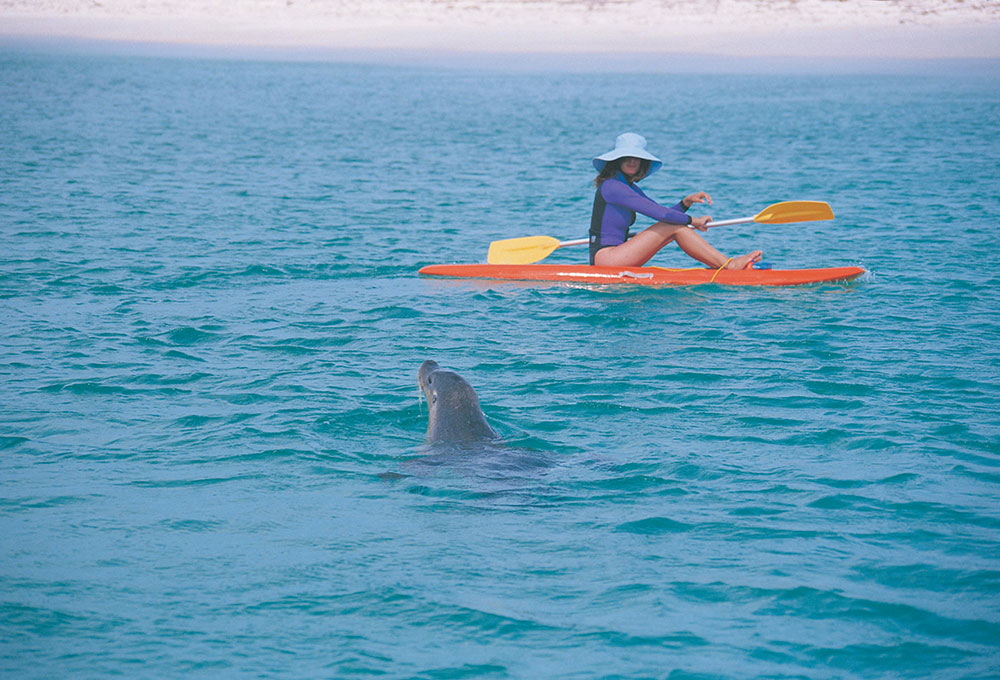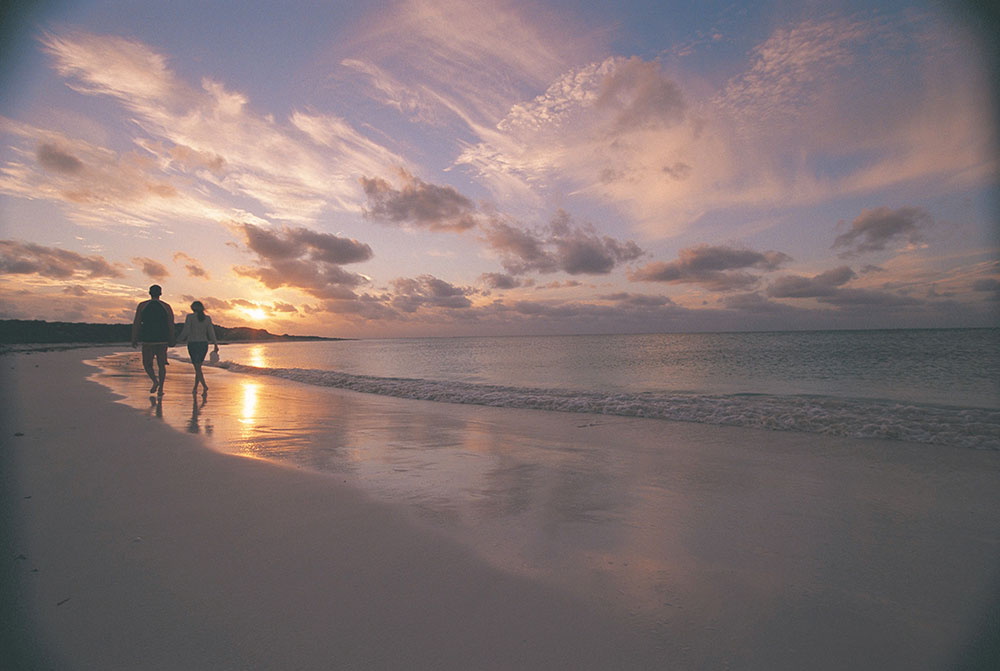Western Australia's rugged gem
Explore a raw islands paradise that boasts a storied past.
.jpg?h=651&iar=0&w=1000&rev=19caa8fce3914182ad250e2ab094839a&hash=8DA2926C8E3B4AC9E05E918B9F8BC17B)
“Look straight down, the wreck is right under the wing’s tip.”
With my face flattened against the window usually reserved for the co-pilot of an eight-seater lightweight plane, I scan the swell slapping against Morning Reef in the Houtman Abrolhos Islands.
It’s a needle-in-a-haystack search. We circle again, our massive bird-like wings turning into a headwind.
“Where those flock of birds are!” David Butt, the pilot, points excitedly as we lean into a 45-degree turn.
It is unmistakable. A wound oozing a luminous icepack-like gel, where the infamous ship Batavia ran aground early morning, 4 June 1629. What occurred afterwards darkened Australia’s history books with a notorious mass murder. The lure of silver guilders and other precious antiquities on board was too hard to ignore in the eyes of skipper Adrian Jacobsz.
The known larrikin and drunk joined forces with sociopath and third-in-charge sea merchant Jeronimus Cornelisz.
It was a lethal pairing and together they plotted a mutiny against the ship’s commander Francisco Pelsaert.
However, gale-force winds and lack of navigational equipment caused havoc when the Batavia smashed into the rocks and the mapped mutiny never unfolded. What happened after, though, was far more horrific. Cornelisz, who was left behind while Pelsaert and his crew searched for water, began a reign of terror, brutally slaughtering 125 men, women and children on nearby Beacon Island.
.jpg?rev=971d749c04ee4049a16a698f86f6bbd7&hash=CAD3A1139F6697876E7AA8D9B3242401)
It did not end well for Cornelisz, as he was hung, drawn and quartered in public while Jacobsz was captured and tortured for negligence.
As David levels the plane’s wings, it’s hard to imagine the dark bloodied past as we fly over an archipelago of aquamarine puzzle-like pieces. Declared a national park in July 2019, the Abrolhos (as shortened by locals) lays 60km off the Geraldton coast, Western Australia.
Three groups span 122 idyllic islands: the Pelsaert Group, Wallabi Group and Easter Group, where Rat Island is located and is our first port of call. The short ruler lookalike runway is surprisingly smooth as we come into land, dispersing hundreds of sooty terns on touchdown. “It’s Tinder for birds,” David muses as I climb down with two other guests.
“The terns arrive, find a date, procreate and return every year.” As one of the world’s most important seabird breeding sites, hundreds of thousands of pairs have been recorded here. Thirty-five species have marked the islands as their breeding ground.
Apart from the terns filling the sky, it’s just the four of us strolling through low-lying shrubs.
The fishers who live here left for the mainland only days ago as an unseasonal October storm ravaged the islands. Still, it’s easy to understand the freedom the islands’ isolation affords away from the restraints of a routinal society.
The rugged beauty is a definite drawcard. There are no palm trees edging boutique hotels, no beauty spas offering pampering menus – just plaques detailing the islands’ ecology in the bush.
We wander past a group of multi-coloured huts that could double as Antarctic shacks and down to the water’s edge where boardwalks branch out like fishermen’s weathered fingers. We find a sea lion pup suckling on its sunbathing mother, stopping briefly to look up, curious to our presence.

Under the balmy sun, I imagine staying longer, months maybe, to experience the city-to-coral-coast lifestyle. We next touch down on uninhabited East Wallabi Island where, again, we have the island to ourselves.
A short walk to Turtle Bay, a popular stretch of beach, sees us gathering handfuls of keepsake shells before reaching a raised platform, our posy for morning tea and lunch.
Close by, bush tracks find us tracking wildlife where we spot an inquisitive tammar wallaby peeking out from the undergrowth.
“The fauna’s so diverse here – it’s often referred to as the Galapagos of Australia,” David tells us as a dwarf bearded dragon darts across our pathway heading for the thicket. Further on, David points to a fallen osprey’s nest.
“Cyclone Seroja knocked it flat to the ground in April this year,” he says. “It was about 3m high, took the ospreys around 10 years to build.” Twisted twigs, ocean debris including toothbrushes, thongs, and even a table-tennis bat lay scattered around the dishevelled base.
It’s another reminder of how exposed the islands are to seasonal Indian Ocean storms. Before we leave, I attempt to squeeze a quick snorkel in, but the recent storm has rendered the water murky, and visibility is low.

“You have to come back,” David suggests. “The sea life is richer than the Great Barrier Reef – there’s a stunning oceanic aquarium teaming with healthy coral around the islands.”
Heading back to the mainland, we fly over Post Office Island where fishers once collected their mail, then on to Little and Big Pigeon Islands, where jetties fan out into deeper waters.
We follow Long Island, which snakes like lace through the Abrolhos, its rough hems highlighted by aqua-emerald shades the colour of opals.
As we circle Morning Reef one last time, the Batavia’s “wound” is all aglow like a beacon to those who lost their lives.
It’s also a ribbon of light, pointing to the stark, striking seascape that spans across the unparalleled beauty that is the Abrolhos.
Writer travelled with support of Australia’s Coral Coast and Tourism Western Australia.
Book your West Australian holiday with RACQ Travel
Related topics
Things to note
The information in this article has been prepared for general information purposes only and is not intended as legal advice or specific advice to any particular person. Any advice contained in the document is general advice, not intended as legal advice or professional advice and does not take into account any person’s particular circumstances. Before acting on anything based on this advice you should consider its appropriateness to you, having regard to your objectives and needs.
Insurance Products (excluding Travel Insurance) are issued by RACQ Insurance Limited ABN 50 009 704 152 (RACQI) and arranged by its agent, RACQ Distribution Services Pty Ltd (RDS) ABN 35 116 361 650, AFSL 567130 and RDS' authorised representatives (including RACQ Operations Pty Ltd ABN 80 009 663 414, AR No. 234978 (RACQO). Conditions, limits and exclusions apply. RDS and RACQO are in the RACQ group of companies. One of the companies in the RACQ group of companies has a minority shareholding in RACQI.
RDS and RACQO have not taken your personal objectives, circumstances or needs into account when preparing advice regarding insurance products and you will need to consider whether the advice is appropriate for you. Read the Product Disclosure Statement (PDS) and any applicable Supplementary PDS before making a purchase decision on this product. You can also access our Target Market Determinations on this website. RDS receives a commission from RACQI for the policies it arranges. RACQO receives fees paid for services it provides to RDS. Further details about remuneration are available on request prior to purchasing.
Banking and loan products issued by Members Banking Group Limited ABN 83 087 651 054 AFSL/Australian credit licence 241195 trading as RACQ Bank. Terms, conditions, fees, charges and lending policies apply. This is general advice only and may not be right for you. This information does not take your personal objectives, circumstances or needs into account. Read the disclosure documents for your selected product or service, including the Financial Services Guide and the Terms and Conditions, and consider if appropriate for you before deciding.
Except for RACQ Bank, any RACQ entity referred to on this page is not an authorised deposit-taking institution for the purposes of the Banking Act 1959 (Cth). That entity’s obligations do not represent deposits or other liabilities of RACQ Bank. RACQ Bank does not guarantee or otherwise provide assurance in respect of the obligations of that entity, unless noted otherwise.
RACQ Bank subscribes to the Customer Owned Banking Code of Practice which establishes higher standards than the law requires. The Code reflects modern consumer expectations and developments in approaches to issues such as consumer vulnerability, guarantors, and supporting customers through financial hardship. Please read our Customer Owned Banking Code of Practice page for more information.
RACQ Operations Pty Ltd (ABN 80 009 663 414 AR 000234978) and Members Travel Group Pty Ltd (ABN 45 144 538 803 AR 000432492) are acting as an Authorised Representative of the issuer of the insurance, Tokio Marine & Nichido Fire Insurance Co., Ltd. (ABN 80 000 438 291 AFSL 246 548). Any advice set out above is general in nature only, and does not take into account your objectives, financial situation or needs. Before purchasing any travel products, please consider the RACQ Travel Insurance Product Disclosure Statement (PDS) and the Target Market Determinations (TMDs) that apply to these products. Whilst the PDS outlines the Terms and Conditions of these products, the TMDs outline the intended class of customers that comprise the target market for these travel products. This will allow you to consider which products best suit your objectives, financial situation and needs and consider the products appropriateness to your personal circumstances. TMDs also outline matters involving the distribution and the review of these products. The PDS, Supplementary PDS and TMDs for each travel product can be found here.